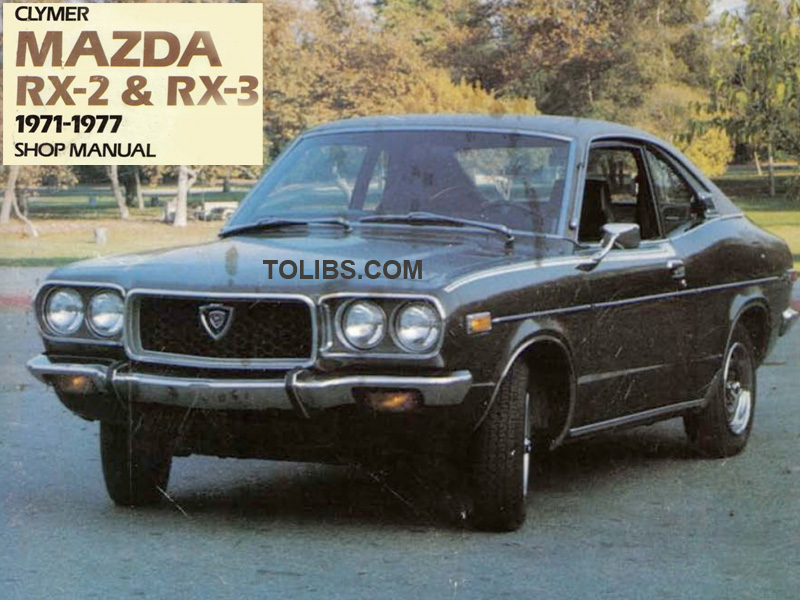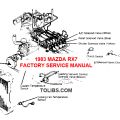Mazda RX2-3 Clymer Factory Service Manual

This book is another in the world's largest selling automobile repair series. Clymer books are noted for delivering more troubleshooting, repair, and maintenance information than any others.
- More photos, drawings, charts
- Compact "carry-along" size
- Emphasis on tune-up, troubleshooting, frequently needed information
- Quick referance pages for vital specs
- More exploded views
- Trick of the trade from factory mechanics
This book provides services information for Mazda RX-2's and RX-3's from 1971 through 1977. Changes affecting 1975 and later RX-3's are covered in a supplement at the back of the book. The RX-2 was not produced after 1974.
The RX-2 and RX-3 are equipped with a 2-rotor Wankel rotary engine. Total rotor displacement is 70 cu, in, (1146cc). Althrough the same engine is used in both cars, the RX-2 uses a less restrictive exhaust system, thus has more horsepower.
The standard transmission is a 4-speed manual. A 3-speed automatic is optional. McPherson strut independent front suspension is used at the front wheels. The brakes are vacuum assisted, with discs at front.
On all U.S. models, the chassis identification number is visible yhrough the driver's side of the windshield. The model identification plate is attached to the cowl. The safety certification label is attached to the left-hand door pillar.
Service Hints
Observing the following practices will save time, effort, and frustration, as well as preventing possible injury.
Through this manual, with 2 exceptions, the word "front" refers to the front of the car. The front of many part is the end nearest the front of the car when the part is installed. The 2 exceptions are the steering whell and the instrument panel. The front of these 2 parts is the side which faces the driver.
The position of the driver also determines "left" and "right". For example, the steering wheel is on the left side. Disconnect one battery cable before working near electrical connections and before disconnecting wires.
Avoid flames or sparks when working near a charging battery or near flammable liquids such as gasoline. Tag all similar internal parts for location, and mark all amting parts for position. Record the number and thickness of any shims as they are removed. Small parts, such as bolts, can be identified by placing them in plastic sandwich bags, sealed and labeled with masking tape
Protect finished surfaces from physical damage or corrosion. Keep gasoline and brake fluid off painted surface. Frozen or very tight bolts and screws can often be loosened by soaking with penetrating oil, then sharply striking the bolt head a few times with a hammer and punch (or screwdriver for crews). Heat is to be avoided unless absolutely necessary, since it may melt, warp, or remove the temper from many parts.
No parts, except those assembled with a press fit, require unusual force during assembly. If a part is hard to remove or install, find out why before proceeding. Cover all openings after removing parts to keep dirt, small tools, etc., from falling in.
When assembling 2 parts, start all fasterners, then tighten evenly. When buying replacement parts, always take the old part to the parts store. If possible, for comparison to the new part. Since Mazda makes design changes in mid-year, write down the chassis number and date of manufacture (on the safety label). Take these numbers along when buying parts.
Manual Organization
This book provides service information and procedures for RX-2's and RX-3's sold in the U.S. through 1974. All dimensions and capacities are expressed in inch units familiar to U.S. mechanics, as well as in metric units. Metric tools are required to work on the RX-2 and the RX-3.
This chapter provides general information and specifications. Chapter Two explains all periodic lubrication and routine maintenance necessary to keep your car running well. Chapter Two also includes recommended tune-up procedures, eliminating the need constantly to consult chapters on the various subassemblies. Chapter Three provides methods and suggestions for quick and accurate diagnosis and repair of problems. Troubleshooting procedures discuss typical symptoms and logical methods to pinpoint the trouble. It also discusses equipment useful both for preventive maintenance and troubleshooting.
Subsequent chapters describe specific systems such as the engine, transmission, and electrical system. Each chapter provides complete disassembly, repair, and assembly procedures in a simple step-by-step form. If a repair is impractical for the home mechanic, it is so indicated. It is usually faster and cheaper to take such repairs to a Mazda dealer or other competent repair shop. Specifications concerning a particular system are included at the end of the appropriate chapter.
Some of the procedures in this manual call for special tools. In all such cases, the tool is illustrated, either in actual use or alone. When practical, a low-cost substitute has been suggested. A well-equipped mechanic may find he can substitute other similar tools already on hand, or can fabricate his own. Also, when a procedure requires a special tool, a great deal of time and expense can be saved by having a dealer or machine shop perform only the step which requires the special tool, but doing the rest of the work yourself.
Lubrication, Maintenance, and Tune-Up
This chapter deals with the normal maintenance necessary to keep the Mazda running properly. It includes summaries of service intervals and procedures in table form. Table 1 covers 1971-73 cars; Table 2 covers 1974s. The recommended service schedules list checks which are easily performed at each stop for gas, and those which are done at specified intervals of miles or time. The last part of the chapter contains a tune-up procedure which simplifies and organizes the process.
Routine Checks
The following should be done at each stop for gas.
- Check engine oil level on the dipstick. Top up to the F mark if necessary, using a grade recomended in Table 3.
- Check coolant level. The radiator should be full and the expansion tank half full. Note: The coolant level should be checked when the engine is cold. If this isn't possible, put a rag over the radiator or expansion tank cap when removing to prevent burns.
- Check the level of the windshield washer tank. It should be kept full.
- Check sub-zero starting assist fluid (if so equipped). The tank is located above the steering gear box (Figure 2). If necessary, top up with a mixture of 90 per cent ethylene glycol-based anti-freeze and 10 per cent water. Make sure the hose inside the tank is submerged in the fluid. Note: if the tank is allowed to be come empty, take the car to a dealer for refilling and pump priming.












